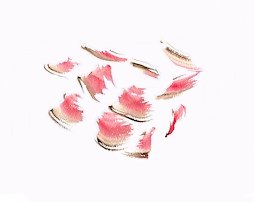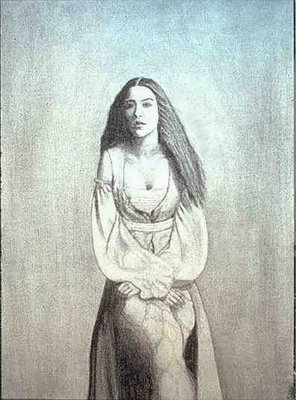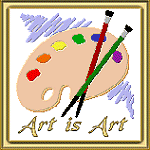Little Pieces of Spirit (TM)
--the art, poetry, musings of M. David Orr. The focus is on spirituality and living. RSS Feed: http://littlepiecesofspirit.blogspot.com/atom.xml (c) Copyright 2006 by M. David Orr
Saturday, July 29, 2006
Poem: Who Can Talk to the Green Field?
Who can talk to the green field,
Who say, "Give me peace?"
What is in the grass,
The sun-yellow filtering through leaves,
That makes us think
We hear the wind's voice,
Tales of wisdom
Spoken by the breeze?
Who can talk to the green field?
Copyright 2006 by M. David Orr
Who say, "Give me peace?"
What is in the grass,
The sun-yellow filtering through leaves,
That makes us think
We hear the wind's voice,
Tales of wisdom
Spoken by the breeze?
Who can talk to the green field?
Copyright 2006 by M. David Orr
Monday, July 24, 2006
Ole Fashioned Butchering
In the 1950s one of the men at my dad's insurance office H.L. Porth and his wife Frances owned a farm just outside Columbia on the west side of town. Several times we went in with the Porths to buy a whole cow or hog, and butchered it ourselves at H.L.'s farm.
It is hard for someone raised in the city on pre-packaged meat to comprehend, but butchering is great fun and a lot of work. People in the city often like to pretend to themselves that the meat they eat from plastic containers somehow just got there by magic without any animal dying--sort of like candy or ice cream. We knew better. The cows, we bought pre-killed from a meat factory. The hogs, we bought live and killed ourselves.
I'll never forget rising one fall morning at the crack of dawn and driving to the stockyard where we picked out a large, black and white hog walking about a pen. The lot attendant cut him out of the herd into a side pen. Dad shot the hog in the head with a .22 rifle and cut his throat while he was still having his death tremors. After the hog deposited most of his blood on the concrete, we loaded him on the pickup truck and drove him to the farm.
H.L had this big oak tree in front of his wood-frame house. From this tree we hung a long rope with a meat hook on the end, on which we hung the hog. The men then began to skin the hog while Frances and Mom cooked a big breakfast of hen-fresh fried eggs, grits with home-made butter, country-white biscuits, fresh sausage, bacon, milk from their own cow, and hot coffee.
It being early, Mom let me drink coffee-milk, which was a half-and-half mixture of the two that I liked. The whole noisy bunch of us, including H.L. and Frances' kids, sat around the kitchen table stuffing ourselves and enjoying each other's company.
After breakfast, the women cleaned up while the men started cutting up the hog, and the kids explored the farm together. The Porth kids showed me how to chase the hens off their nest to collect the still-warm, brown and speckled eggs. They showed me how to milk a cow, and on one occasion how to churn butter from milk.
I tasted fresh, warm, unpasteurized milk (not good), and drank a lot of pasteurized milk that had not been homogenized. This milk, when put in a bottle and chilled, developed a two-inch thick layer of yellow cream at the top. Before drinking it, we would shake the bottle to mix it up with the white part, but it never mixed with quite the completeness that machine homogenized milk mixes. We, therefore, had little flecks of cream spread throughout the milk, each of which was delicious on the tongue.
About mid-morning, the men had enough butchering done that the women and children could start their work. We began by rendering fat. To render fat, we put chunks of it in a large kettle and covered it with water, then boiled it until the fat reduced into small, crisp, amber nuggets called cracklings (pronounced "Cracklin's".) These we would later add to cornbread giving it a meaty flavor with little crunchy bursts of flavor scattered throughout.
We also cut up the fattier portions of the lean meat for sausage filling. After seasoning the meat, we stuffed it in the hog's intestines, which made a perfect casing for the meat. This we cut up and tied into twelve-inch lengths suitable for a meal. We did a similar operation with the pig liver, cutting it up for sausage as well. Liver sausage was my favorite and you couldn't buy it very easily in the store.
We also made corn meal mush. Mush was made by adding hog juice and fat to corn meal and molding it into cakes that we'd later cut up and fry for breakfast. The women made chitterlings--I'm not sure how--and other exotic things that the Orr family had less interest in than the Porth's.
I'm not sure whether they pickled the pigs feet or not, but that was also another thing people down there did with the hog. We, of course, saved the brains and blanched them in salt water. These we later mixed with eggs for scrambling. Their creamy texture and subtle flavor perfectly complemented eggs. They even had a way of preparing the skin after removing the bristles, so it was crunchy and delicious.
Down South, when they butcher a hog, there is a saying that they use every part except the oink. We weren't quite so thorough--about the only thing we hadn't used was the eyeballs, the bristles, and, yes, the oink.
It is hard for someone raised in the city on pre-packaged meat to comprehend, but butchering is great fun and a lot of work. People in the city often like to pretend to themselves that the meat they eat from plastic containers somehow just got there by magic without any animal dying--sort of like candy or ice cream. We knew better. The cows, we bought pre-killed from a meat factory. The hogs, we bought live and killed ourselves.
I'll never forget rising one fall morning at the crack of dawn and driving to the stockyard where we picked out a large, black and white hog walking about a pen. The lot attendant cut him out of the herd into a side pen. Dad shot the hog in the head with a .22 rifle and cut his throat while he was still having his death tremors. After the hog deposited most of his blood on the concrete, we loaded him on the pickup truck and drove him to the farm.
H.L had this big oak tree in front of his wood-frame house. From this tree we hung a long rope with a meat hook on the end, on which we hung the hog. The men then began to skin the hog while Frances and Mom cooked a big breakfast of hen-fresh fried eggs, grits with home-made butter, country-white biscuits, fresh sausage, bacon, milk from their own cow, and hot coffee.
It being early, Mom let me drink coffee-milk, which was a half-and-half mixture of the two that I liked. The whole noisy bunch of us, including H.L. and Frances' kids, sat around the kitchen table stuffing ourselves and enjoying each other's company.
After breakfast, the women cleaned up while the men started cutting up the hog, and the kids explored the farm together. The Porth kids showed me how to chase the hens off their nest to collect the still-warm, brown and speckled eggs. They showed me how to milk a cow, and on one occasion how to churn butter from milk.
I tasted fresh, warm, unpasteurized milk (not good), and drank a lot of pasteurized milk that had not been homogenized. This milk, when put in a bottle and chilled, developed a two-inch thick layer of yellow cream at the top. Before drinking it, we would shake the bottle to mix it up with the white part, but it never mixed with quite the completeness that machine homogenized milk mixes. We, therefore, had little flecks of cream spread throughout the milk, each of which was delicious on the tongue.
About mid-morning, the men had enough butchering done that the women and children could start their work. We began by rendering fat. To render fat, we put chunks of it in a large kettle and covered it with water, then boiled it until the fat reduced into small, crisp, amber nuggets called cracklings (pronounced "Cracklin's".) These we would later add to cornbread giving it a meaty flavor with little crunchy bursts of flavor scattered throughout.
We also cut up the fattier portions of the lean meat for sausage filling. After seasoning the meat, we stuffed it in the hog's intestines, which made a perfect casing for the meat. This we cut up and tied into twelve-inch lengths suitable for a meal. We did a similar operation with the pig liver, cutting it up for sausage as well. Liver sausage was my favorite and you couldn't buy it very easily in the store.
We also made corn meal mush. Mush was made by adding hog juice and fat to corn meal and molding it into cakes that we'd later cut up and fry for breakfast. The women made chitterlings--I'm not sure how--and other exotic things that the Orr family had less interest in than the Porth's.
I'm not sure whether they pickled the pigs feet or not, but that was also another thing people down there did with the hog. We, of course, saved the brains and blanched them in salt water. These we later mixed with eggs for scrambling. Their creamy texture and subtle flavor perfectly complemented eggs. They even had a way of preparing the skin after removing the bristles, so it was crunchy and delicious.
Down South, when they butcher a hog, there is a saying that they use every part except the oink. We weren't quite so thorough--about the only thing we hadn't used was the eyeballs, the bristles, and, yes, the oink.
Gold

Oh, walk me down an ancient path
You charted when the stars were young.
The stones and dust I pick my way among,
The briars that tear my arm and calf,
Have not discouragement enough to slow my way,
When gems and stones of gold betray the path
To be so old, so old, so old.
God! my heart has never failed to leap
When spotting gems and stones upon the road.
My feet, as tiredness flees, begin to dance
And trip a light quick-step
Toward the mother lode.
I know these roads and trails that every day
Take prospectors through barren lands,
Through bayous damp, and desert heat and cold,
While every day new trails are struck,
And every day a tourist stuck
In mud, or heat, or cold,
But I can smell the old,
And lead my self along the pathway stones.
Copyright 2006 by M. David Orr



